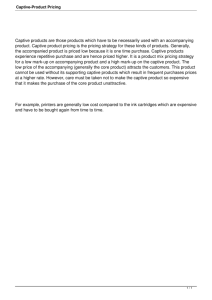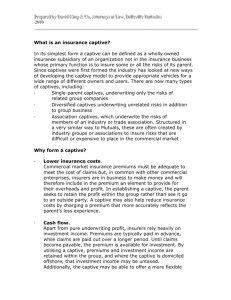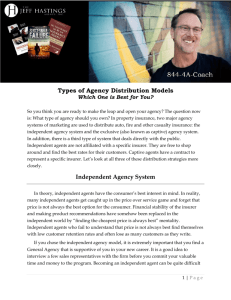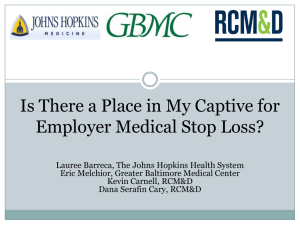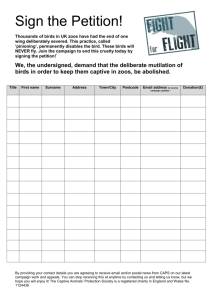Textbook Key Terms for Flash Quiz
advertisement
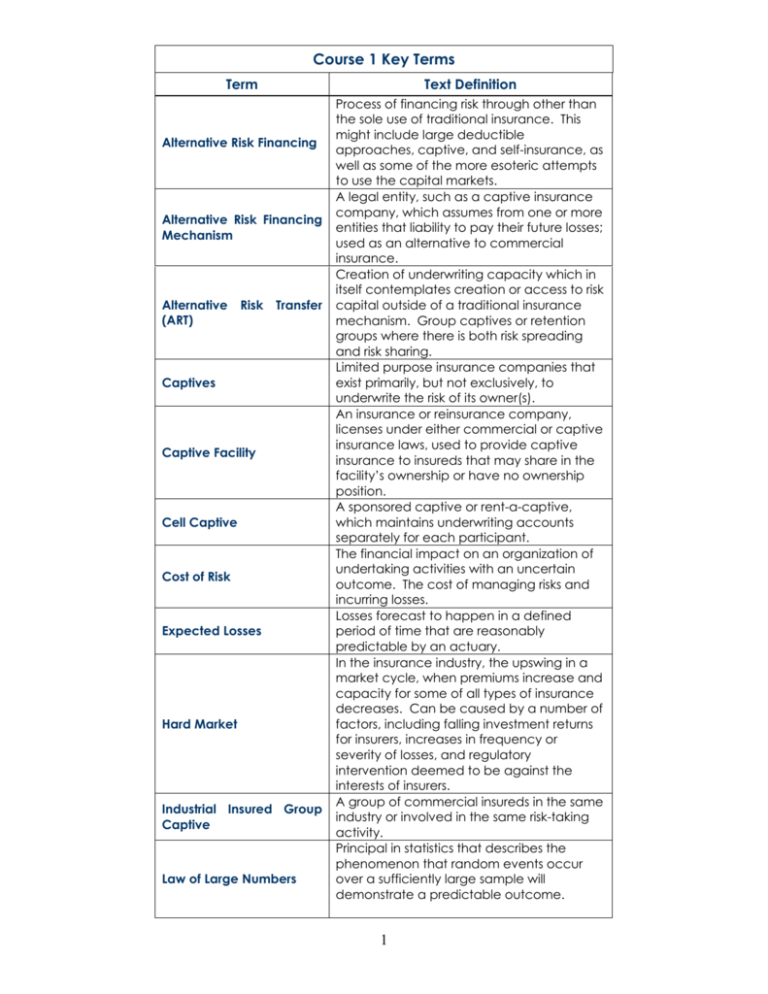
Course 1 Key Terms Term Text Definition Alternative Risk Financing Alternative Risk Financing Mechanism Alternative (ART) Risk Transfer Captives Captive Facility Cell Captive Cost of Risk Expected Losses Hard Market Industrial Insured Group Captive Law of Large Numbers Process of financing risk through other than the sole use of traditional insurance. This might include large deductible approaches, captive, and self-insurance, as well as some of the more esoteric attempts to use the capital markets. A legal entity, such as a captive insurance company, which assumes from one or more entities that liability to pay their future losses; used as an alternative to commercial insurance. Creation of underwriting capacity which in itself contemplates creation or access to risk capital outside of a traditional insurance mechanism. Group captives or retention groups where there is both risk spreading and risk sharing. Limited purpose insurance companies that exist primarily, but not exclusively, to underwrite the risk of its owner(s). An insurance or reinsurance company, licenses under either commercial or captive insurance laws, used to provide captive insurance to insureds that may share in the facility’s ownership or have no ownership position. A sponsored captive or rent-a-captive, which maintains underwriting accounts separately for each participant. The financial impact on an organization of undertaking activities with an uncertain outcome. The cost of managing risks and incurring losses. Losses forecast to happen in a defined period of time that are reasonably predictable by an actuary. In the insurance industry, the upswing in a market cycle, when premiums increase and capacity for some of all types of insurance decreases. Can be caused by a number of factors, including falling investment returns for insurers, increases in frequency or severity of losses, and regulatory intervention deemed to be against the interests of insurers. A group of commercial insureds in the same industry or involved in the same risk-taking activity. Principal in statistics that describes the phenomenon that random events occur over a sufficiently large sample will demonstrate a predictable outcome. 1 Participant Producer-owned Reinsurance Company Pure Captive Reinsurance Pool Risk Capital Risk Management Process Risk Purchasing (RPG) Risk Securitization Groups A mathematical concept which postulates that the more times an event is repeated (in insurance, the larger the number of homogeneous exposure units), the more predictable the outcome becomes. In a classic example, the more times one flips a coin, the more likely the results will be 50% heads, 50% tails. An insured that utilizes a captive insurance company through a participant contract specifying the terms of participation, rather than through a shareholder or member contract. A captive or rent-a-captive cell owned or used by a broker or managing general agent for reinsurance of selected risks that it produces for the purposes of retaining the underwriting income. May be set up by insurance companies to circumvent state laws regarding the amount of commissions that can be paid to their producing agents. A captive insurance company that has as its primary business purpose the insurance of the risks of its shareholders and affiliates. A risk financing mechanism used by insurance companies to increase their ability to underwrite specific types of risks. The insurer cedes risk to the pool under a treaty reinsurance agreement. The insurer may be a part owner of the pool and may assume a quota share of the pool risk. A captive reinsurance pool may be owned by the original insureds. Some pools are operated by states to provide capacity for hard-to-place risks. The amount of capital required to support the retention of risk by a self-insurer or underwriter of risk. In insurance, the term capital can be used to mean both capital (paid-in-equity) and surplus. Series of steps taken to manage risk. A group of unrelated insureds jointly purchasing liability insurance pursuant to the terms of the federal Risk Retention Act of 1986. The use of a debt or equity instrument (security) to finance risk, using a risk index to value the security and/or a specified loss event as a determinant of the interest or repayment date. Risk securities are issued by a special purpose vehicle (SPV). 2 Self-insurance Pool Sophisticated Insured Sponsor Underwriting Capacity A legal entity regulated by the states that allows unrelated insureds to retain their own risks and collectively purchase claims administration services and excess insurance to meet statutory coverage requirements. An insured not requiring the same level of protection under insurance laws as an average insurance consumer. The legal entity that contributes statutory capital to form a sponsored or association captive. The risk retention ability of an insurer, or of the insurance industry as a whole. Determined by the amount of surplus. The maximum amount of money an insurer or reinsurer is willing to risk in a single loss event on a single risk or in a given period. The limit of capacity for an insurer or reinsurer that may also be imposed by law of regulatory authority. 3

